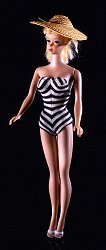






Childhood Experiences
Alba, a college student living in the Southeastern US, but who grew up in Nicaragua provided the following reflections on her childhood experiences of Barbie.
|
When I was growing up in Nicaragua, Barbie was a symbol of status. . . . I came to see Barbie for the first time when I was eight or nine. . . . My single mom and her three children had just moved to a relatively nice, middle-class neighborhood in Managua. My little neighbors, who soon became my friends, had Barbie dolls. . . . They had the dolls AND the house, the Ken doll, and the extra clothing and accessories. The girl next door to them . . . had two or three Barbies, one of which could ride a bicycle! Soon my sister and I were asking incessantly for Barbie dolls. . . .
What Barbie meant to us then can be reduced to having. We did not look like Barbie, nor did we aspire to . . . [T]he great thing about Barbie was that she could have so much! Two-storey houses (rare in Nicaragua, only for the well-off), convertible cars (never seen in our world), clothes, pools, bicycles—the more our Barbies had, the more we had. . . . No one I knew had as much—all shiny, all perfect and pink. |
From, Mary Rogers, Barbie Culture, London and Thousand Oaks, CA: Sage Publications, 1999, p. 64.

 Enlarge Image
Enlarge Image
Barbie Doll
Domestic Life Collection
1988.0608
SI Neg.# 94-3264
Anonymous Gift, 1988



Description | 1 | 2 | 3 | 4
Home | Artifacts & Documents | Writing Assignments | Teaching Guide | Essays